The NVIDIA SHIELD Android TV Review: A Premium 4K Set Top Box
by Ganesh T S on May 28, 2015 3:00 PM EST- Posted in
- Media Streamer
- Home Theater
- TV
- 4K
- Shield
- NVIDIA
System Performance
From an editorial perspective, the SHIELD Android TV may be one of the most frustrating devices we’ve worked on in recent history. Simply put, the Android TV market is still a tiny market. Google’s Nexus Player is most of the market right now, and only very recently have other Android TV devices such as the Forge TV and SHIELD Android TV reached the market.
As a result, figuring out what to compare the SHIELD Android TV to and how to present it has been an interesting challenge. A set top box is not a mobile device, and while they share similar OSes and the same families of SoCs, that does not make them identical devices. At the same time however, if we restrict ourselves to just Android TV devices, it would be a very limited and uninteresting comparison. The Nexus Player is a quad-core Intel Atom, but only includes 1GB of RAM, among other limitations.
Ultimately it’s clear that the SHIELD Android TV is heavily overspeced compared to other Android TV devices – no one else is pursuing this premium market – so instead we’re going to focus on looking at benchmarked performance relative to the newest generation of SoCs in the latest iOS and Android tablets. This is by no means a fair matchup and we need to be clear about this – the SHIELD Android TV has no throttling or power constraints, no need to balance out energy efficiency – but it at least gives us some idea of how the device and Tegra X1 compare to other products. Just don’t expect to see a Tegra X1 tablet perform this well. And in the meantime, some of the results may surprise you.
As always for an Android device review, we'll start off with our browser benchmarks. SHIELD Android TV doesn’t actually ship with a browser – we had to sideload Chrome – but these are among our most flexible benchmarks and help put performance in context of more than just Android devices.
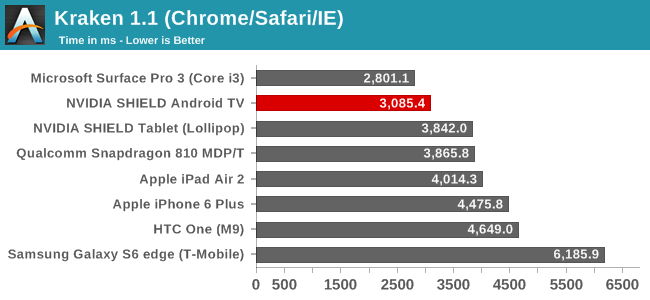
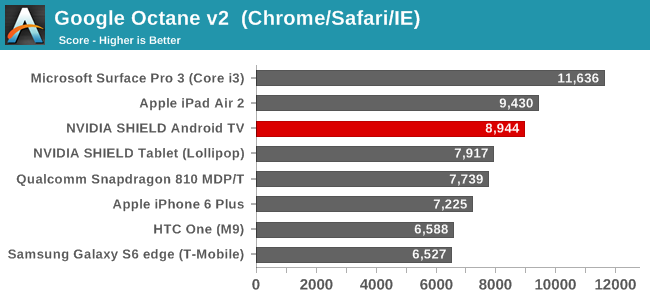
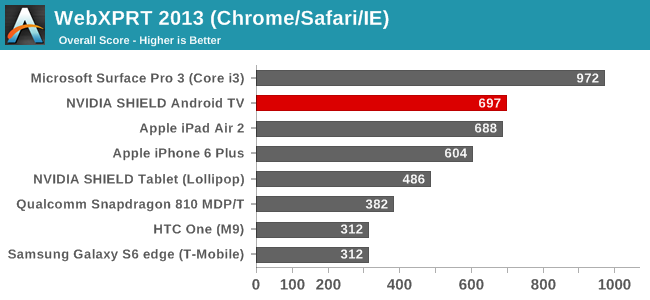
Among Android devices, the SHIELD Android TV stands alone, as you’d expect. Without any throttling to hold it back, it leads over Tegra K1, Snapdragon S810, and Exynos 7420 over all 3 web benchmarks. That said, even with its unrestricted Cortex-A57 CPU cores, we also find that Apple’s A8X-based iPad Air 2 is a close match in Octane and WebXPRT, just edging out the SHIELD Android TV and being edged out respectively. Meanwhile for anyone curious how this compares to high-end x86 tablets like the Surface Pro 3, well even SHIELD Android TV isn’t quite up to par with those devices at this time.
Moving on, we have Basemark OS II 2.0, which should give a better picture of CPU performance in addition to overall device performance.
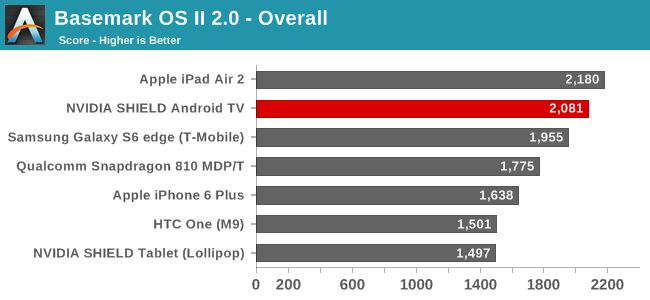

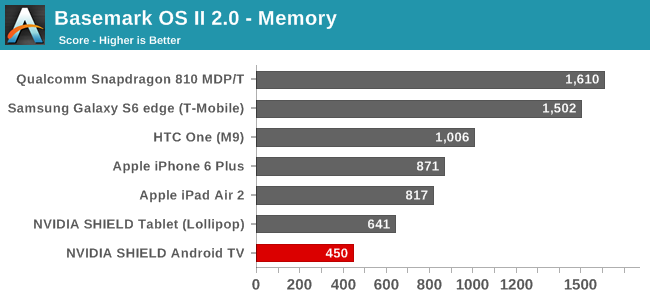
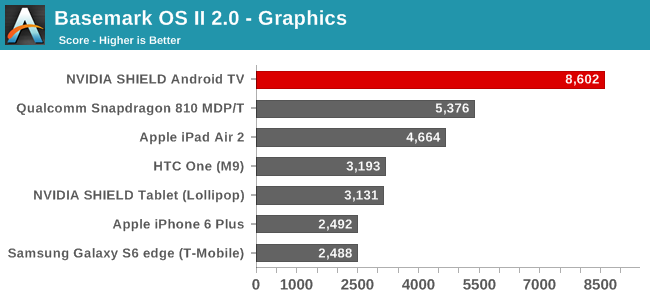
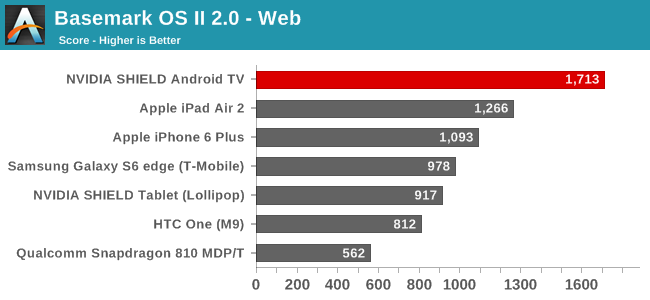
Overall, performance under Basemark still slightly favors the iPad Air 2. SHIELD Android TV easily takes the second spot, but it’s not enough to catch Apple’s tablet.
Looking at the subscores, we can see why this is. SHIELD Android TV only fares decently under the System test, but not well. The big surprise here is not the iPad, which always does well, but the fact that the SHIELD is so far behind the Galaxy S6, which features a similar CPU setup. As this sub-test pushes both the CPU and memory, we may be seeing something related to the implementation differences between Tegra X1 and Exynos 7420, or it may just be an Android TV-inspired difference.
However the memory score is particularly bad, coming in behind even the last-generation SHIELD Tablet. As this is a NAND test, what we're likely seeing is a consequence of the SHIELD's poor random performance, something we'll dive into a bit later in our detailed look at NAND performance.
On the other hand, graphics and web performance are outstanding. We had certainly expected the SHIELD to do well in graphics given what Maxwell is capable of – it is a graphics monster unlike any other current SoC – but the web test is a pleasant surprise. The combination of using Android TV’s built-in web view and the lack of any real throttling likely play a big part here, and although Android TV doesn’t ship with a standard web browser, this bodes well for any apps making use of web view and Javascript.
Our next system benchmark is PCMark, which does a number of basic benchmarks designed to stress various aspects of the device in everyday workloads like video playback, web browsing, text editing, and photo editing. This tends to test every aspect of a mobile device, unlike microbenchmarks that can often miss aspects of the system that can affect performance.
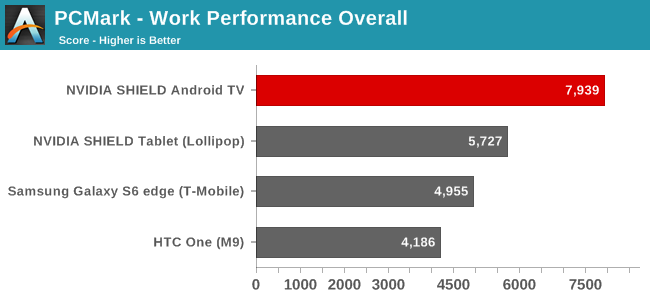
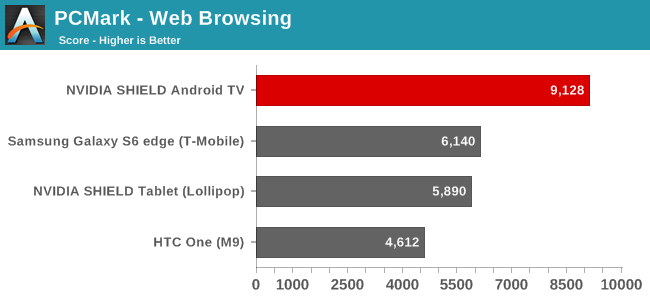

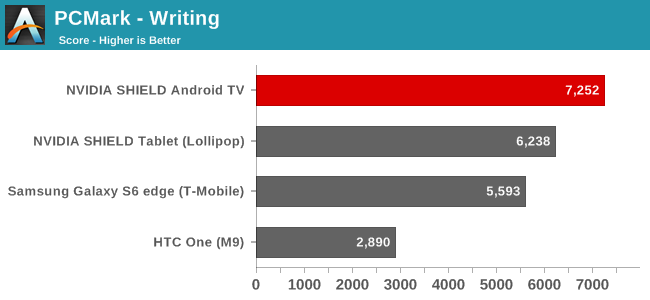
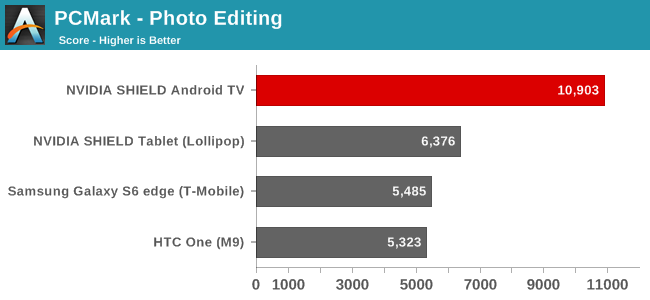
With the exception of the Writing subtest, where the SHIELD Android TV and second-place device are kind of close, PCMark is a runaway victory for the SHIELD Android TV. Once again we’re almost certainly seeing the benefits of the box’s aggressive performance since it doesn’t need to throttle down, or even be conservative on clockspeeds for power purposes. In which case it gives us an interesting look at what Cortex-A57 can do when not held back.
Overall, CPU/system performance is more or less what one would expect based on the design of the SHIELD. As a set top box with a quad-core A57 implementation under the hood and the cooling to let it run wild, SHEILD is frequently A57 at its best. Which means it’s going to easily surpass other A57 devices in most situations, but it also means that even with its unrestricted performance, Apple’s A8X processor and its tri-core “Enhanced Cyclone” CPUs still serve as a reminder of those times where A57 struggles against Enhanced Cyclone’s high-IPC design.
For our final look at system performance, let’s take a quick look at the SHIELD's built-in NAND performance with AndroBench 4.0.
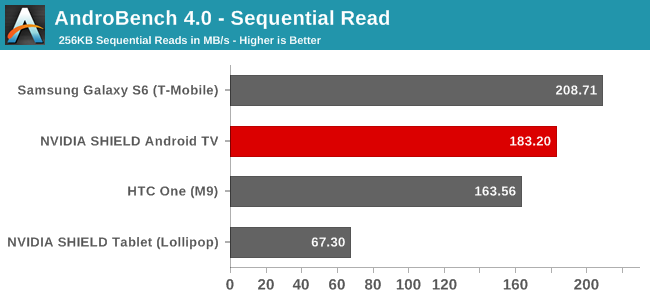
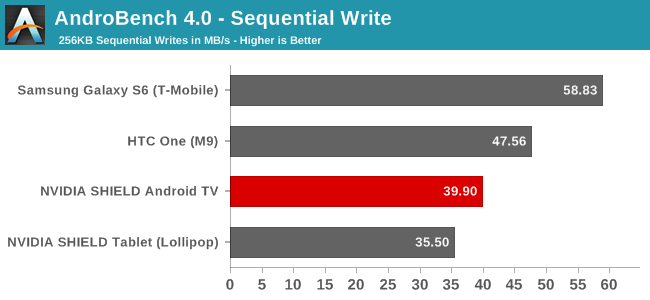
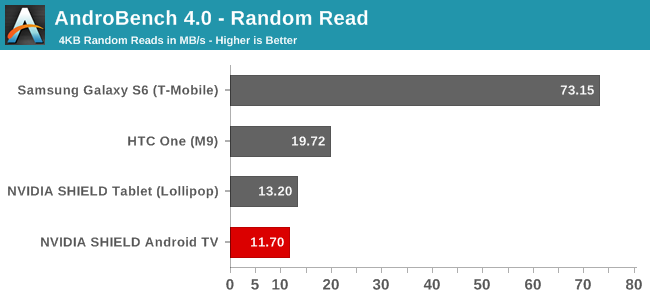
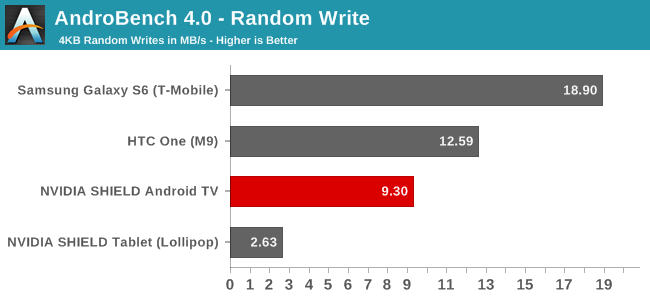
Update 5/28: AndroBench numbers have been revised to account for an error, sorry about that
Though we only have a few AndroBench 4.0 results compiled so far, it’s enough to paint a decent picture. For sequential reads the SHIELD’s built-in NAND fares relatively well. It’s not enough to top the Galaxy S6 and its UFS flash, but it’s keeping up with the pack. Sequential writes on the other hand aren't quite as good, with write performance ahead of only the SHIELD Tablet. Meanwhile random performance is a real mixed bag; the SHIELD Android TV is at the bottom of the random read chart - below even the SHIELD Tablet - while random write performnace is significantly better than the tablet, but still chasing the M9 and well off the S6.
Among Android flagship devices UFS definitely gives the Galaxy a big benefit here, but the SHIELD could stand to improve all the same. However I’m not sure how much that matters to NVIDIA, as the SHIELD is clearly designed to lean on external storage via microSD/USB for users who end up using it for storage-intensive needs such as gaming as opposed to basic set top box streaming.










167 Comments
View All Comments
tipoo - Thursday, May 28, 2015 - link
Certainly seems performant enough, but will it get any exclusives. Even to the entire shield platform at least. Android games are....Ok, but hardly take advantage of the latest and greatest chips, most run fine even on my Moto G. Streaming is also neat, but I'd really like to see some exclusives that really target these high end chips with controllers.ganeshts - Thursday, May 28, 2015 - link
Yes, NVIDIA has indicated around 20 exclusive titles are coming to Tegra K1 and X1-based SHIELD devices.Jumangi - Friday, May 29, 2015 - link
What titles. I hope no body thinks they will be even remotely close to AAA level experiences. No developer is going to risk that kind of money on this machine. They will be cheesed low end android crap.TheJian - Friday, May 29, 2015 - link
Not sure what you're talking about. With unreal 4 and unity 5 engine support on android now you'll start to see some REAL games and they already have real PC ports (serious sam 3, Trine2, Portal, halflife 2, KOTOR etc). You might say PC ports are old (but they are AAA games), but if you know the sales #'s of each of these you understand not more than ~10mil played any of these titles that NOW can easily be ported to Android for a FULL (albeit older) PC game experience. More of these will likely come first, but by this xmas or next we'll start to see what unity5 and unreal 4 can produce. We are already way past angry birds...LOL. Trine 2 isn't a great looking title? That's a 2011 PC game. What exactly do you want? Trine2 runs on K1, we're already at X1 and 14nm Samsung fabbed version is coming for xmas (likely with return of Denver cpu amped up and more polished). We are not even taxing X1 yet, and the xmas version at 14nm will eat it alive. You clearly don't browse android games much to see what is already ported or new out there.This console has more power than an xbox360 or ps3. Not sure why you'd think we're talking Minecraft here or something. If you called xbox360/ps3 AAA experiences what is the difference? You can call that barely beating last gen, but this is the new xbox360/ps3 experience for the poor (or alternative gaming for me that isn't PC etc) who can't afford xbox1/ps4 price tag nor the $60+ games prices that come with those.
On top of that, you don't need a $600-1000 PC to play at 1080p 60fps. For a monthly fee of even $15 (180/yr) you'd get FAR more than 3 console games at $60ea correct? Right now (free) you get 50 games that can stream like this and surely many more coming year after year. The sheer value of GRID gaming here is massive for a person who doesn't have $60 a month to keep their kid playing xbox1/ps4 games. I'm going to guess there will be a $10 fee for 720 and $15 for 1080p gaming but you can insert whatever numbers you want here, I'm just making the point about affordability for amount of fun you get. Mind you as graphics amp up, GRID keeps you from needing to upgrade. Nvidia can easily make sure you're always getting the fps that is being sold to you. They can keep dropping servers around also to keep latency in check.
To your dev point, incorrect. Worst case scenario they can make it exclusive for 6mo-1yr then if sales suck port to PC or allow regular android to use it. You are forgetting that 1yr from now ALL gpus (14nm by then everywhere) will have X1 levels of gpu and if that's not the case by then 10nm isn't far behind. Also if NV wins the suit, everyone will be paying for NV gpu IP (great for devs) at some point. IF you make an unreal4/unity5 game here, you can easily port the thing to PC probably in a few weeks tops and it is running the exact Nvidia hardware there for ~75% of the discrete market on PC's. You're mistakenly acting as if you make a TEGRAZONE based game (meaning special for NV tegra hardware effect), it can NEVER run anywhere else...LOL.
It took a few weeks to port most of these titles.
http://www.tegrazone.com/games/witcherba
Just an example of your crappy games.. Looks pretty fun to me.
http://www.tegrazone.com/games/oddworldsw
Listen to the dev. 1st time in 1080p on mobile etc. Can't beat the price of $6 either. Full 20+hrs just like all the other full games I mentioned that MOST of the world hasn't even played. We see some REALLY great PC games being made for $2-10mil, so I'm pretty sure a dev aiming at top tegra devices won't have a problem shifting titles elsewhere if needed 6 months-1yr later. They are coming with a shield update this xmas (or before) too, so at some point you're going to have millions on these anyway much like a console and that's not counting the fact that lawsuits may lead to all of mobile being NV/AMD at some point (on the gpu side, ARM whatever on the cpu side). I can see myself playing many games with key/mouse on BT when gamepads don't work right also (large rpg game like Baldurs Gate on TV for instance etc). Like I said, massive cheap ports first, then use the cash from those to fund BIG new IP. At worse making a potent game here, only means you'll wait for 2yrs for everyone to be able to play it as gpu power surpasses X1 for even the junker tablets/phones etc at 10nm. IF you don't like waiting that long port to PC etc. You seem to not understand 2Billion units are sold yearly from here on out, which means 2Billion can play any android AAA title very soon. Far faster than say, waiting for consoles to get even 50mil on either side of MSFT or Sony (what is that 5yrs from now?). I'll take the 2Billion side if I'm a dev as GDC 2014/2015 surveys both show they have.
NV can also pay $2-4mil x 25 games to get exclusives they perhaps OWN (say 20mil on 5 top exclusives yearly? Hopefully more?), and then do the same at a later date by porting to PC etc. It's not risky knowing they can port easily to the same gpu on PC. I really hope they start funding games in this range for AAA experiences aimed at X1+. At some point they'll tell us numbers sold on a unit (maybe xmas handheld or android tv here), but not likely until they have a million unit sales launch or something. Maybe they'll wait for an unreal 4 engine showcase game to give us that data. Imagine what 10nm HBM2 version of Tegra will bring to the table...ROFL. Hopefully something from AMD then too for this type of stuff.
http://www.tegrazone.com/news/tabletssurpass
EA, tablets will surpass consoles, and add more to the bottom line THAN consoles. Simple math. Starting 2017 consoles have a real problem if not before as better games launch. HBM2 with 10nm socs will make some waves in replacement devices for what we have today and many problems will be created even at 14nm shortly as everyone rolls that out probably a few devices using HBM1 too in this next gen of ARM devices etc. WiiU just hit 10mil devices sold, and they have some AAA experiences correct? ;) Vainglory from iOS just got ported to NV. Between apples next devices (A9), NV's current and their next model at xmas, qcom's next model (after 810), etc you will have a 100mil+ (likely far higher) that can do X1 gpu levels and likely with 128bit bus everywhere adding more fuel. I really don't get your point ;) Have you seen modern combat 5 blackout or asphalt 8, Order & chaos online, Dungeon Hunter 4 etc? Not angry birds and neither aimed at X1 levels. Haters gonna hate I guess...
darkich - Friday, May 29, 2015 - link
I doubt he'll even read your comment but I can say, thank youJumangi - Friday, May 29, 2015 - link
It has nothing to do with capabilities. Try and understanding what I was actually saying. No developer is going to invest the time and money needed to make high end games for this thing. The return on investment isn't even remotely there.Odey - Friday, May 29, 2015 - link
I am really not sure what you are talking about. Border Lands, the new Metal Gear, Doom3, Half Life, Star Wars series, Portal, Shadow Run, and many more..and I am sure that they will get the newer games as well.heygeo - Friday, July 31, 2015 - link
I understand what your trying to say and also agree, its about having limited engineering resources and the IMMEDIATE return on having them churn out product that will have the best chance of selling the most... in other words when you look at who out there owns this thing (remember not talking about all Android users just the ones with the graphical horsepower) its minute vs say PCs and consoles... while gaming is a passion to us its a business to them and in a crowded gaming platform field this one doesn't have the user base or differentiation to stand out.farble1670 - Friday, May 29, 2015 - link
Xbox / PS4 for the poor?if you look at the reasonable model, the one with the 500GB drive, it's only $50 less than the Xbox One and the PS4, which are orders of magnitude more powerful than the Shield. for only $40 more, wouldn't you want a top of the line next generation gaming console with hundreds of games and hundreds more committed?
if you're looking at the 16GB model (with 10GB of usable space), you won't be able to load more than a few high-end games. you can load them onto an SD card, but that's slower, and you *can't* store game data on the SD card, so if it's a game that downloads content, you're screwed.
i wanted to love the shield, but the price is silly. there's just no way they can compete with the subsidized prices of the Xbox One and PS4.
mkozakewich - Saturday, May 30, 2015 - link
"...orders of magnitude better..."I'm pretty sure they aren't. I'd be surprised if the consoles get more than 6x the performance.
(That would equate to something like a comparison between 10fps and 60fps for a given display size, so it's not like it means nothing, but that's not even ONE order of magnitude.)